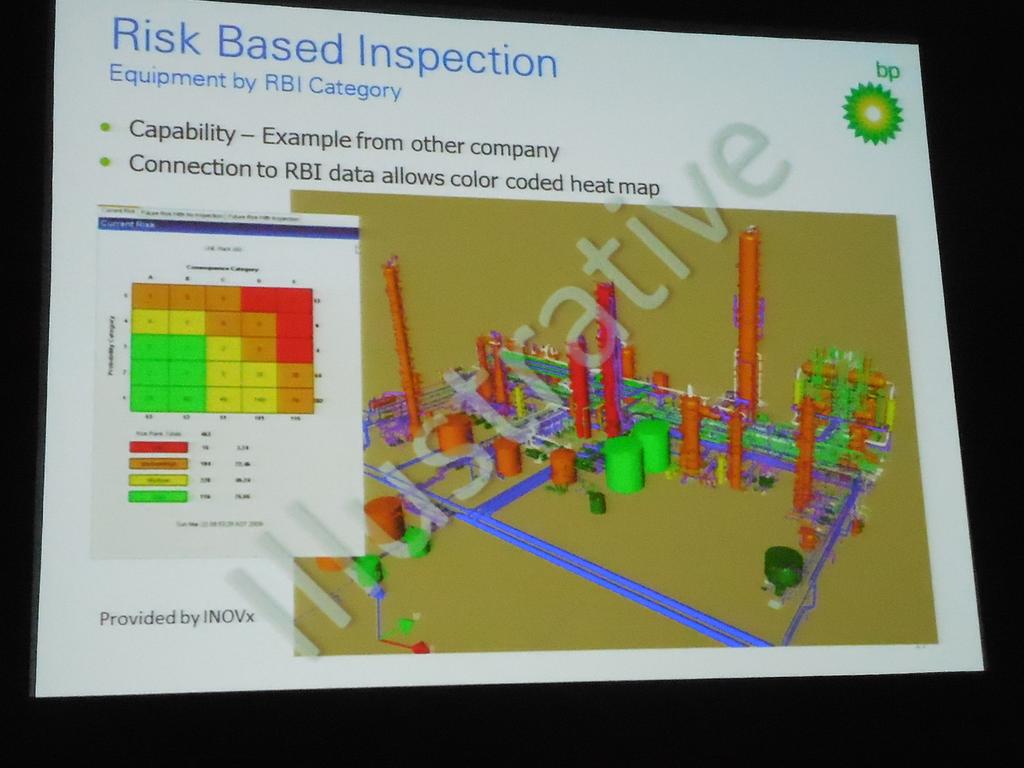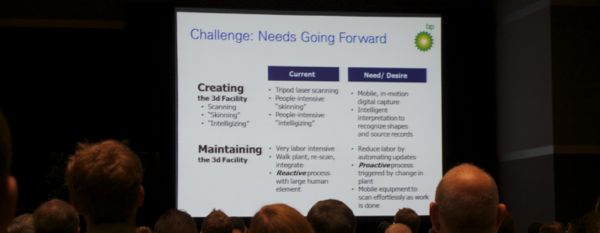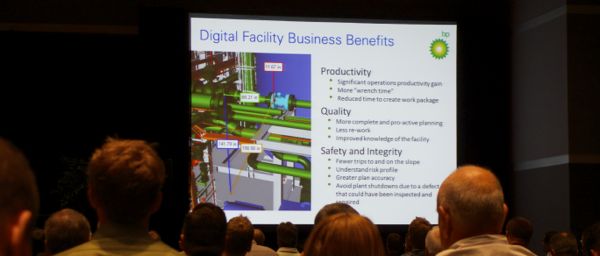Dave Truch, Technology Director in the CTO at BP, followed up on two keynotes discussing the great potential of 3D technology by asking a question on behalf of the energy industry (and asset owners in general). “So what? How much of this can I use and what difference does it really make?”
As he started to answer, Truch asked the audience to keep three things in mind. “The first is that we do believe it is very possible to capture the physical world in digital form at a high fabrication quality. The second is that this is not new. I’m not going to be telling you anything new. But what hasn’t happened is the technology really hasn’t embraced the operation space–at least in our sector.” The third thing, he explained, is that committing to maintaining a digital version of your assets in the high-quality 3D that is used for engineering and other purposes already, “you can make an absolutely radical change to the way you do your operations.”
Without a well maintained digital facility, he noted, none of the augmented reality headsets or whole lifecycle asset management is possible. It’s the first and most important step in putting 3D to work beyond the engineering stage. Truch knows because BP has done it.
Truch explained why BP bit the bullet by describing a group of facilities the company keeps in Alaska–they’re dark, cold, and difficult to get to because they’re out in the middle of nowhere. The facilities, which were designed to control fluids under pressure, comprise a lot of pipelines spread out over about 500 square miles. If you are head of inspection for these facilities, they present you with a very large problem. How do you understand the context of what is happening at these facilities, understand the reliability of the facilities and what condition they’re in? Your easiest answer has generally been to send engineers from far away to complete inspections, and then go to the facilities yourself.
A better solution: a 3D virtual facility. “If we had a virtual facility in existence, would I have to go there to do these things?” Truch asked. “The answer is no.”
Truch explained that BP scanned a whole facility in Alaska, skinned the point cloud and then turned it into an intelligent model. “Then,” he said, “we provided access. Today, if I was in Anchorage and I needed to look at a slope facility and I need to see some particular aspect of it, I can go to my laptop and get into that environment. More importantly, I can be collaborating with others as I’m doing that.”
BP’s virtual facility, a fully up-to-date model that the company has been using for two years, allows them to do work digitally that used to require physical presence. But that’s not the end of it, Truch explained. “Let’s think of what I can do in a digital environment that I can’t do, even if I went to the physical facility. I can’t see context in the large. The things that I can do with the technology,” he said, “are about understanding the whole breadth of what’s going on with that particular separation facility.”
BP created the model to be a catalog of “full 3D assets,” which are tagged to the asset ID, which relates back to BP’s records. This allows you to see an incredible amount of information. “What I also can do in a digital facility is actually add or subtract insight,” Truch said as he pointed at a single asset highlighted within a model. “I can see other structural elements around it, I can isolate other elements around it. Even if I’m physically there, it’s hard to visualize, it’s hard to see, it’s hard to understand. The insight that one gets from something like this is quite phenomenal.”
The rest of Truch’s presentation focused on what BP has done with this digital facility. “One could, because you have access to the back-end source records, you could go into risk-based inspection programs. This means I can determine the risk profile here and color code it. I can say, What are the hottest spots of my facility that I better start focusing on this year?”

You could also begin to perform system-based inspections, he said. “That’s the other thing that’s extremely challenging to do with a facility that’s this massive and large. How would I know what are the lines that are just running my oil? Or my gas? Or my water? Or, bleed-off valves?” When you’re in the physical environment, he explained, it is very difficult to understand how all the parts of the very large system are working together.
This gives the owner of the virtual facility even more value. Truch showed how you can use it to create a colored model that shows an on-site worker the order in which they should perform inspection. The virtual facility can also help you to perform an isolation process, showing the best order of events for getting to a specific part and fixing it or removing it.
With a digital representation of the physical assets, the isolation process can be planned in collaboration between people on site and off site–multiple teams talking through the entire process, figuring out what to do and what order to do it in. All of this is possible because everyone is looking at the same up-to-date records, all seeing the same assets, all looking at the same dimensional elements. Everyone has the necessary information.
“The reality of it is that, in today’s world, without the virtual facility, something like this takes us literally weeks to put together,” Truch said. With a virtual facility, it can take mere days. This saves money, of course, but it also makes the virtual facility a valuable tool for health and safety because it helps minimize the time spent by people in a cold, dark, and dangerous environment.
Bringing 3D into operations and keeping a virtual facility has changed BP’s workflows to such an extent that Truch did not have time to cover everything. “We are embracing this whole notion that there is significant value in ensuring that one has an up-to-date digital asset. It’s as valuable as the physical asset.”
One note Truch made toward the end operates as a tidy way to sum up his entire keynote. “It allows us to operate in the future.”

BP’s Needs for the Future
But that doesn’t mean that BP doesn’t need anything from manufacturers going forward. Right now, Truch said, it requires scanners on tripods and a lot of man hours to create a model. The maintainance of the model is the same–scanning and processing. “It’s a reactive process in the sense that we are told by the facilities manager what has occurred to say you better scan this area because enough has changed that it wouldn’t be prudent to make a business decision without that change incorporated.”
“We need to get more of this moved to the proactive side of the fence,” Truch said, and cited companies working on intelligent interpretation to recognize shapes. “We really need this with some immediacy to bring down the cost and help us be able to scan this across Alaska and the rest of the country.”
Other things on his wishlist: automated updates to the model, true fabrication quality data through the whole process, ways to find out what has been scanned, better interoperability between current technologies, eye safety, and, of course, reduced cost. To maintain the model, BP wants a way to automatically compare new scans against the model and see what has changed.
A last thing on the wishlist, and something that most can relate to: Truch asks for a way that workers out in the field can scan as they go. “The human will still be in play, but wouldn’t it be wonderful if, in doing any of their jobs, they were also a mobile sensor? And so constantly scanning by their movement around. Our real goal is to say, if I do a change to the facility, as a part of the MOC–the management of change–if someone was able to take a device like a handheld or a helmet and scan the change.”
“Then,” Truch notes, “my frequency of update is as frequent as my management of change. Our MOC says the last thing you do, scan it, get it updated to the model so that as-is is as updated as our MOC process.”
According to Truch it is vitally important for the 3D industry to fill these gaps before the virtual facility can reach its full potential within operations.






